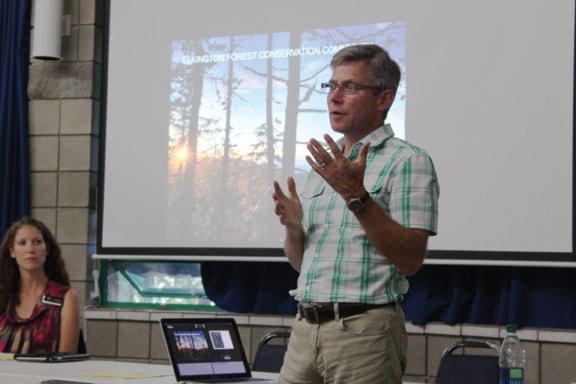As building begins at the unconventional Elkington Forest development in Shawnigan Lake, developers are making a move to include some lower cost options that will increase density at the site by allowing duplexes, secondary suites, daycare and school uses.
What makes Elkington Forest unique is that it is a forest conservation effort as well as a community development.
The idea is to build "a hamlet of people who see themselves as the stewards of that forest," explained Doug Makaroff, president of Living Forest Communities, speaking for the developers at a public meeting at the Shawnigan Lake Community Centre on July 10 on the bylaw amendments needed to make the proposed changes to the plan.
Conventional subdivisions take a lot of land, Makaroff said. The developers of Elkington Forest wanted it to be different, and so after examination of a number of popular European neighbourhoods, they settled on a plan to cluster housing in a way that is "a complete alternative approach to conventional urban sprawl".
The Elkington Forest property is 1,000 acres in total. Using an 85 per cent/15 per cent formula, 850 acres of the land will be conserved as working forest on a model similar to that pioneered by Island forester Merv Wilkinson, in "the most sustainable form of forestry or ecoforestry that we have in this province." The remaining 150 acres will be a combination of housing hamlets, community spaces and agricultural land.
The new density Elkington Forest is seeking, which will allow 97 residential units compared to the original 77, will not create a larger development footprint, Makaroff assured, it will simply change the configuration of some of the existing lots.
The reason for the proposed changes is to both be able to offer some lower cost options to buyers and to help pay for the project. Things have changed since the initial concept was brought forward, Makaroff explained. The financial crash of 2008 along with the desire to use only the most eco-friendly of sewer and wastewater systems have stretched the original projected budget.
"There are financial realties that we have to be aware of," he said. "Our biggest fanbase are people who often have trouble getting into the [housing] market."
The Trailhead Hamlet is the first phase of the project and lots are selling now. Roads, sewer, water, power and telecommunications have been put in since last summer.
The development will incorporate things such as solar panels, and they are looking into the possibility of creating a rainwater capture system to be used for irrigation.
Part of the property has been allotted for three parks that will be turned over to the ownership of the CVRD. Trails will make their way through the acreage for public use, and the developer will be building a public barbecue pavilion and washrooms where the property intersects with the Trans Canada Trail. Ann Mortifee, co-founder of the Trust for Sustainable Forestry, has built a home in the Trailhead Hamlet that is being used as a show home.
"If our shared community conservation model could capture only one per cent of real estate transactions, the new revenues going into conservation projects would surpass all of the charitable
donations to land conservation organizations worldwide," said Mortifee. The sentiment of wanting to create a community that would serve as a model that will be used in other places was echoed by Makaroff as he explained this is part of the reason for the need to make the building of development profitable. If it is not, nobody will follow in their footsteps.
Overall the development seems to be a popular one with the community, and approval for the increased density looks like it will pass without difficulty, as only six people attended the Thursday public meeting, and only one written response was received by the CVRD.
Of those that attended the meeting only one individual, Larry Anderson, spoke out against the bylaw changes, though even he expressed a general approval of the development itself.
"I fail to understand how extra people and density will improve this location," he explained his objections. "This all boils down to money."
He wanted a payment of $50,000 per new lot to be paid to the CVRD, stating that as is, there is no benefit for the taxpayer in approving the changes. Cliff Evans disagreed. "What they're doing is the best thing that could ever happen to that property," he said, pointing out that the community value comes from conserving the forest there rather than seeing it fall to clear cutting.
